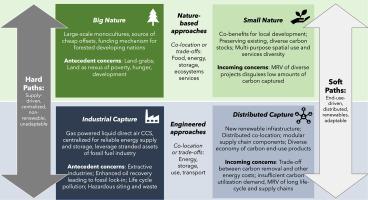Global Environmental Change ( IF 8.6 ) Pub Date : 2022-05-19 , DOI: 10.1016/j.gloenvcha.2022.102530 Sean Low , Chad M. Baum , Benjamin K. Sovacool

|
Carbon removal – also known as negative emissions technologies, or greenhouse gas removal – represents a core pillar of post-Paris climate policy, signaling for enhancing and constructing carbon sinks to balance emissions sources on route to ambitious temperature targets. We build on Amory Lovins’ “hard” and “soft” alternatives for energy pathways to illuminate how foundational experts, technologists, and policy entrepreneurs think about different modes of resource inputs, infrastructure and livelihoods, and decision-making, regarding ten nature-based and engineered carbon removal approaches. Based on 90 original interviews, we show that hard and soft paths reflect different conceptions of systems, spaces, and societal involvement. We highlight that pathways depend on diverging concepts of economies-of-scale (capturing carbon at the largest possible scale, versus catalyzing systemic co-benefits) and carbon management (a waste product within conventional climate governance, versus diverse end-uses and values to be diversely governed). Our analysis further emphasizes two key uncertainties: whether renewables can be upscaled to allow synergies rather than tradeoffs between carbon removal and more widespread energy demands, and whether carbon certification can expand spatially to navigate long supply chains, and conceptually to incentivize diverse co-benefits. Experts remain motivated by antecedent concerns over land-use management and extractive industries, and that exploitative systems will – without guardrails – be replicated by inertia.
中文翻译:

重新思考净零系统、空间和社会:基于自然和工程碳去除的“硬”与“软”替代方案
碳去除——也称为负排放技术或温室气体去除——代表了巴黎后气候政策的核心支柱,为加强和构建碳汇以平衡排放源以实现雄心勃勃的温度目标发出信号。我们以 Amory Lovins 的“硬”和“软”能源路径替代方案为基础,阐明基础专家、技术专家和政策企业家如何思考资源投入、基础设施和生计以及决策的不同模式,涉及十种基于自然的和工程碳去除方法。基于 90 个原始访谈,我们表明硬路径和软路径反映了系统、空间和社会参与的不同概念。我们强调,路径取决于不同的规模经济概念(以尽可能大的规模捕获碳,而不是催化系统性的协同效益)和碳管理(传统气候治理中的废物产品,而不是多样化的最终用途和价值)实行多元化管理)。我们的分析进一步强调了两个关键的不确定性:是否可以升级可再生能源以实现协同效应,而不是在碳去除和更广泛的能源需求之间进行权衡,以及碳认证是否可以在空间上扩展以驾驭长供应链,并在概念上激励各种共同利益。专家们仍然受到对土地使用管理和采掘业的先前担忧的推动,并且剥削系统 - 没有护栏 - 将被惯性复制。与催化系统的共同利益)和碳管理(传统气候治理中的废物,与不同的最终用途和价值进行不同的治理)。我们的分析进一步强调了两个关键的不确定性:是否可以升级可再生能源以实现协同效应,而不是在碳去除和更广泛的能源需求之间进行权衡,以及碳认证是否可以在空间上扩展以驾驭长供应链,并在概念上激励各种共同利益。专家们仍然受到对土地使用管理和采掘业的先前担忧的推动,并且剥削系统 - 没有护栏 - 将被惯性复制。与催化系统的共同利益)和碳管理(传统气候治理中的废物,与不同的最终用途和价值进行不同的治理)。我们的分析进一步强调了两个关键的不确定性:是否可以升级可再生能源以实现协同效应,而不是在碳去除和更广泛的能源需求之间进行权衡,以及碳认证是否可以在空间上扩展以驾驭长供应链,并在概念上激励各种共同利益。专家们仍然受到对土地使用管理和采掘业的先前担忧的推动,并且剥削系统 - 没有护栏 - 将被惯性复制。我们的分析进一步强调了两个关键的不确定性:是否可以升级可再生能源以实现协同效应,而不是在碳去除和更广泛的能源需求之间进行权衡,以及碳认证是否可以在空间上扩展以驾驭长供应链,并在概念上激励各种共同利益。专家们仍然受到对土地使用管理和采掘业的先前担忧的推动,并且剥削系统 - 没有护栏 - 将被惯性复制。我们的分析进一步强调了两个关键的不确定性:是否可以升级可再生能源以实现协同效应,而不是在碳去除和更广泛的能源需求之间进行权衡,以及碳认证是否可以在空间上扩展以驾驭长供应链,并在概念上激励各种共同利益。专家们仍然受到对土地使用管理和采掘业的先前担忧的推动,并且剥削系统 - 没有护栏 - 将被惯性复制。











































 京公网安备 11010802027423号
京公网安备 11010802027423号